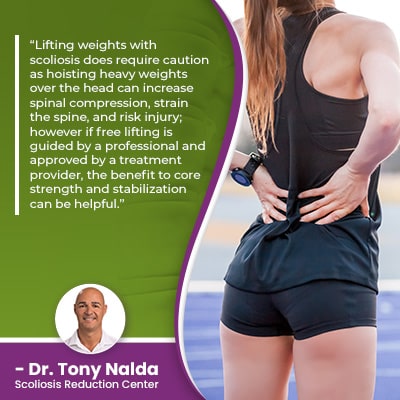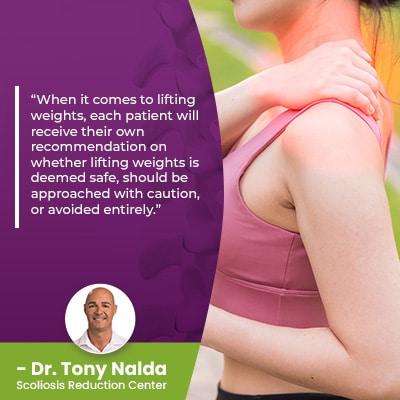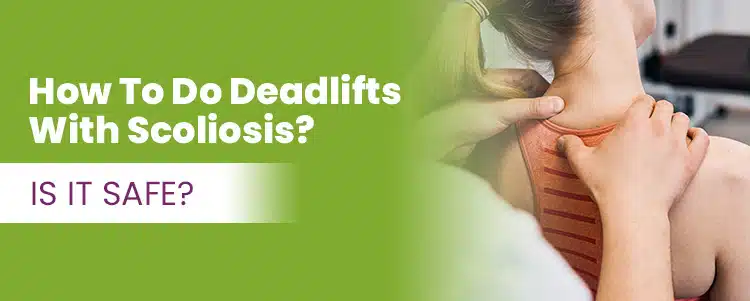There was a time when a scoliosis diagnosis was thought to mean a life of limitations, but we have learned enough about the condition, and how to treat it effectively, to know that doesn’t have to be the case. When it comes to whether or not lifting weights with scoliosis is safe, the answer will be case-specific.
The world’s record-holding power lifter was diagnosed with adolescent idiopathic scoliosis when he was 14, but his diagnosis didn’t stop him from thriving and dominating competitive weight-lifting, despite having an unnaturally-curved spine.
As activity recommendations/restrictions are case-specific, let’s address why no two cases of scoliosis are the same.
Diagnosing Scoliosis
Before scoliosis can be treated effectively, an official diagnosis is needed, and as there are a number of spinal conditions that involve a loss of healthy spinal curves, scoliosis has some characteristics that set it apart.
A scoliotic curve doesn’t just bend unnaturally to the side, but also twists, and it’s the condition’s 3-dimensional nature that makes it unique and particularly complex to treat.
In addition, the size of the unnatural spinal curve is a requirement; in order to be considered a true scoliosis, the patient’s Cobb angle has to be at least 10 degrees.
A patient’s Cobb angle is a measurement that’s determined during X-ray that tells me how out of alignment the spine is:
- Mild scoliosis: Cobb angle measurement of between 10 and 25 degrees
- Moderate scoliosis: Cobb angle measurement of between 25 and 40 degrees
- Severe scoliosis: Cobb angle measurement of 40+ degrees
- Very-severe scoliosis: Cobb angle measurement of 80+ degrees
In healthy spines with their natural curves and alignment in place, the vertebrae (bones of the spine) are stacked on top of one another in a straight and neutral position, but if one or more vertebral bodies become tilted, the spine is no longer aligned.
So scoliosis introduces a lot of uneven forces to the body, and as a progressive condition, scoliosis has it in its nature to worsen over time, and that means the size of the scoliotic curve will increase, as will the condition’s uneven forces, and their effects.
Because it’s progressive, where a scoliosis is, in terms of severity, at the time of diagnosis doesn’t mean that’s where it will stay; only proactive treatment can work towards counteracting the condition’s progressive nature.
It’s far more effective to work towards preventing progression than it is to attempt to reverse its effects once they’re established; the main condition effect in children is postural deviation, and the main symptom of scoliosis in adults is pain.
Part of diagnosing scoliosis involves comprehensively assessing conditions so they can be further classified based on key patient/condition variables, of which there are so many, which is why no two cases of scoliosis are going to be the same.
Conditions are classified based on patient age, curvature location, condition type, and severity, and in addition, there are also different curvature types and patterns.
So when it comes to lifting weights, is this generally a safe activity for people with scoliosis?
How to Lift Weights with Scoliosis?
Lamar Gant is the world’s deal-lifting record holder, and his story is the perfect one to inspire and motivate.

Despite being diagnosed with scoliosis when he was 14, a condition both his mother and grandmother also had, he continued to thrive.
While there are some cases that are too severe and/or are atypical so have different activity restrictions, in a typical case of adolescent idiopathic scoliosis, a number of activities can be continued, as long as they are first cleared by a patient’s scoliosis treatment provider, and they are approached with caution.
When it comes to activity restrictions, some sports that are often deemed unsafe for people with scoliosis include tennis, golf, gymnastics, and football.
Activities that overuse one side of the body aren’t safe because they can exacerbate the condition’s asymmetrical effect, and gymnastics, ballet, and diving can involve hyperextending and straining the spine, and repeated shock from impact adds more compressive forces to the body and spine.
But what about lifting weights? Lifting weights uses the body symmetrically and can be modified accordingly.
Lifting weights, if approved by a patient’s treatment provider, can be a positive means of increasing core strength, which helps scoliosis by providing the spine with more spinal support from its surrounding muscles, and increasing core strength is also a key facet of treatment.
Lifting weights with scoliosis does require caution as hoisting heavy weights over the head can increase spinal compression, strain the spine, and risk injury; however if free lifting is guided by a professional and approved by a treatment provider, the benefit to core strength and stabilization can be helpful.
How Did Lamar Gant Lift With Scoliosis?
When Lamar Gant was 17 years old, he only weighed 123 pounds, and he’d been diagnosed with scoliosis three years before, but he still went on to set his first world record of deadlifting over 500 pounds.
In 1980, Gant was inducted into the International Powerlifting Federation Hall of Fame, and five years later, he earned his next title as the first person to deadlift five times his body weight: he lifted 661 pounds while only weighing 132 pounds himself.
Gant still holds the 123- and 132-pound world-deadlifting records.
So Gant shows us that each case of scoliosis is, indeed, unique, and that each patient will respond in their own unique way; he also helps debunk the scoliosis myth that the condition automatically means muscle weakness and shows that hard work can counteract some challenging condition effects.
Gant followed guidance on how to safely deadlift, and he didn’t ignore his scoliosis, so he was able to adjust his dream accordingly, but still followed it.
Should I Deadlift with Scoliosis?

Part of a proactive treatment approach means providing lifestyle guidance for patients, and that includes helping them find a balance of healthy scoliosis-friendly activities, sports, and exercises.
While there was a time when the place of exercise in treatment was questioned, we have since learned that it’s extra important for people with scoliosis to stay active and strong.
When it comes to lifting weights, each patient will receive their own recommendation on whether lifting weights is deemed safe, should be approached with caution, or avoided entirely.
Activity restrictions can be given because they are deemed unsafe for an already-vulnerable spine and/or because they can interfere with treatment.
Certain weight-lifting maneuvers like deadlifting straight over the head does increase the weight on the spine, and this means more compression, and for adults, scoliosis is already a compressive condition (scoliosis doesn’t become compressive until skeletal maturity has been reached).
So in some cases of severe, or very-severe scoliosis, or in atypical cases where, say, the scoliotic curve bends to the left, instead of the right, deadlifting can be deemed too strenuous for scoliosis patients, but in other cases, particularly in milder cases with younger patients for whom scoliosis is not yet compressive, deadlifting can be deemed safe when performed under the watchful eye of a scoliosis treatment provider and/or physical therapist.
Conclusion
What Lamar Gant shows us, along with a number of other famous individuals and athletes with scoliosis, is that a diagnosis doesn’t have to define a person or limit them in any way, particularly if the scoliosis is being addressed with proactive treatment.
As scoliosis introduces so many uneven forces to the body, activities need to be approved to ensure they are not introducing more adverse tension and strain to a spine that’s already facing the challenge of having an unhealthy spinal curve, along with rotating unnaturally.
Certain sports and activities that strain the spine, increase compression, place it in an unnatural position, or overuse one side of the body should be approached with caution and only performed if cleared by a patient’s scoliosis treatment provider.
Each case of scoliosis is unique, which is why the complex nature of the condition necessitates the customization of effective treatment plans, and here at the Scoliosis Reduction Center®, I do just that.
By integrating chiropractic care, physical therapy, corrective bracing, rehabilitation, and lifestyle guidance, I can help patients work towards reducing their scoliosis on a structural level, increase core strength for more spinal support, and provide guidance on whether or not activities like deadlifting are safe; all things that help patients maintain a positive quality of life.




